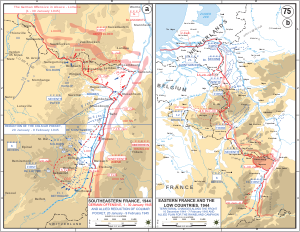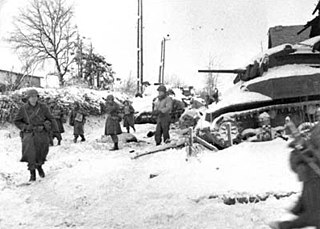
The Battle of the Bulge, also known as the Ardennes Offensive, was the last major German offensive campaign on the Western Front during World War II which took place from 16 December 1944 to 25 January 1945. It was launched through the densely forested Ardennes region between Belgium and Luxembourg. The offensive was intended to stop Allied use of the Belgian port of Antwerp and to split the Allied lines, allowing the Germans to encircle and destroy each of the four Allied armies and force the western Allies to negotiate a peace treaty in the Axis powers' favor.

The 14th Armored Division was an armored division of the United States Army assigned to the Seventh Army of the Sixth Army Group during World War II. It remains on the permanent roll of the Regular Army as an inactive division, and is eligible for reactivation. The division is officially nicknamed the "Liberators".

The VI Corps was activated as VI Army Corps in August 1918 at Neufchâteau, France, serving in the Lorraine Campaign. Constituted in the Organized Reserves in 1921, it was allotted to the Regular Army in 1933 and activated on 1 August 1940 at Fort Sheridan, Illinois. VI Corps took part in some of the most high-profile operations in World War II.

The Siegfried Line campaign was a phase in the Western European campaign of World War II, which involved actions near the German defensive Siegfried Line.
The 1st Army was a field army of the German Army which participated in World War II. Formed on 26 August 1939 in the Wehrkreis XII military district and surrendering 6 May 1945 near Munich, it fought exclusively on the Western Front.

The First Army was a field army of France that fought during World War I and World War II. It was also active during the Cold War.
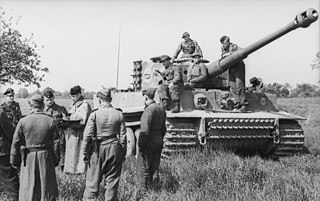
The 7th Army was a World War II field army of the German land forces.
The 21st Panzer Division was a German armoured division best known for its role in the battles of the North African Campaign from 1941 to 1943 during World War II when it was one of the two armoured divisions making up the Deutsches Afrikakorps (DAK).

The Colmar Pocket was the area held in central Alsace, France, by the German Nineteenth Army from November 1944 to February 1945, against the U.S. 6th Army Group during World War II. It was formed when 6th AG liberated southern and northern Alsace and adjacent eastern Lorraine, but could not clear central Alsace. During Operation Nordwind in December 1944, the 19th Army attacked north out of the Pocket in support of other German forces attacking south from the Saar into northern Alsace. In late January and early February 1945, the French First Army cleared the Pocket of German forces.
The XXXIX Panzer Corps was a German panzer corps which saw action on the Western and Eastern Fronts during World War II.
Army Group G fought on the Western Front of World War II and was a component of OB West.

The XV Corps of the US Army was initially constituted on 1 October 1933 as part of the Organized Reserves, and was activated on 15 February 1943 at Camp Beauregard, Louisiana. During the Second World War, XV Corps fought for 307 days in the European Theater of Operations, fighting from Normandy through France and southern Germany into Austria. The corps was commanded in combat by Major General Wade H. Haislip, initially as a subordinate unit to the Third U.S. Army and later as part of the Seventh U.S. Army.

The Upper Rhine High Command, known for three days as Army Group Upper Rhine, was a short-lived headquarters unit of the German Armed Forces (Wehrmacht) created on the Western Front during World War II. The Upper Rhine High Command was formed on 26 November 1944 and deactivated on 25 January 1945. The sole commander of this headquarters unit was Heinrich Himmler.

The 116th Panzer Division, also known as the "Windhund (Greyhound) Division", was a German armoured formation that saw combat during World War II.
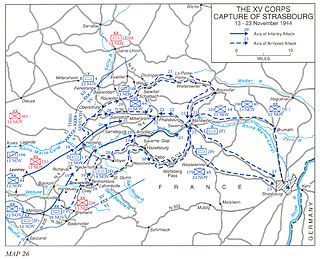
The liberation of Strasbourg took place on 23 November 1944 during the Alsace campaign in the last months of World War II. After the liberation of Mulhouse on 21 November 1944 by the 1st Armored Division, General Philippe Leclerc de Hauteclocque, and the 2nd Armored Division entered the city of Strasbourg in France after having liberated Sarrebourg and La Petite-Pierre from Nazi Germany, which cleared the way to Strasbourg.
Operation Nordwind was launched by German ground forces on 31 December 1944 against U.S. and French ground forces in the Rhineland-Palatinate and the Alsace and Lorraine regions of southwestern Germany and northeastern France as part of the European Theatre in World War II. It ended on 25 January 1945.
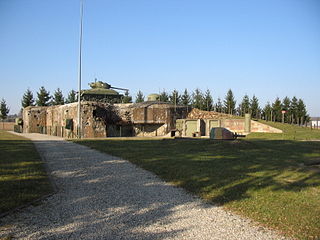
The Fortified Sector of Haguenau was the French military organization that in 1940 controlled the most easterly section of the Maginot Line, to the north of Strasbourg. The left (western) wing of the Haguenau sector adjoined the Fortified Sector of the Vosges, includes two of the largest Maginot fortifications, Ouvrage Hochwald and Ouvrage Schoenenbourg. The right wing, started after 1931, was progressively scaled back in order to save money during the Great Depression, abandoning plans for four petit ouvrages and substituting casemates. The sector's northern and eastern sides bordered on Germany. To the south the sector borders the Fortified Sector of the Lower Rhine, from which it received several casemates in a boundary shift in 1940.

Major General Roderick Random Allen was a senior United States Army officer, who commanded the 20th and 12th Armored Divisions during World War II. Under his command of the 12th AD, the division defended Strasbourg from recapture; it provided the armored contingent in the closure of the Colmar Pocket and the liberation of Colmar; it spearheaded General George Patton's drive to the Rhine; captured intact the remaining bridge over the Danube River and broke the German defense line; and played a major part in blocking the Brenner Pass, thereby trapping over a million German soldiers in Italy as the war ended. En route to the Brenner Pass it overran eleven concentration camps at Landsberg, Germany.

The Seventh Army was a United States army created during World War II that evolved into the United States Army Europe (USAREUR) during the 1950s and 1960s. It served in North Africa and Italy in the Mediterranean Theater of Operations and France and Germany in the European Theater between 1942 and 1945.
The 553rd Volksgrenadier Division was a volksgrenadier division of the German Army during World War II that fought entirely on the Western Front.
